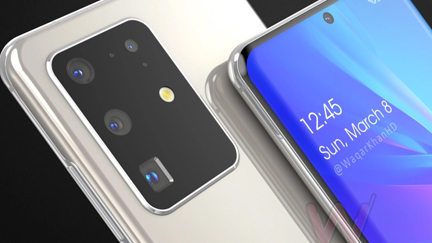
Samsung Galaxy S20 is a line of smartphones designed, developed, marketed, and manufactured by Samsung Electronics as part of its Galaxy S series. They collectively serve as the successor to the Galaxy S10 and were unveiled at Samsung's Galaxy Unpacked event on 11 February 2020.
The S20 line consists of flagship Galaxy S20 and Galaxy S20+ models differentiated primarily by screen size, as well as a larger camera-focused model, the Galaxy S20 Ultra. Key upgrades over the previous model, in addition to improved specifications, include a display with a 120 Hz refresh rate and an improved camera system supporting 8K video recording and a super-resolution zoom of 30-100x, depending on the model.
Design : The Galaxy S20 series maintains a similar design with the Samsung Galaxy Note 10, with an Infinity-O display (first introduced in the Galaxy S10) containing a circular punch-hole in the top center for the frontal selfie camera. In a departure from past Galaxy S designs, the camera array is not centered, but located in the corner with a rectangular protusion; the S20 and S20+ house three or four cameras respectively in the bump, while the S20 Ultra houses four cameras in a larger bump. The S20 is available in three colors: Cosmic Grey, Cloud Blue, and Cloud Pink, while the S20+ is available in Cosmic Grey, Cloud Blue, and Cosmic Black. The S20 Ultra is available in Cosmic Black and Cosmic Grey.
Hardware : The S20 line comprises three models with various hardware specifications; international models of the S20 utilize the Exynos 990 system-on-chip, while the US models utilize the Qualcomm Snapdragon 865. A 1440p "Dynamic AMOLED" is featured with HDR10+ support and "dynamic tone mapping" technology. The S20 and S20+ have a 6.2-inch display and a 6.7-inch display, respectively, while the S20 Ultra has a 6.9-inch display. The displays have curved sides that slope over the horizontal edges of the device, and the display itself has a wider 20:9 aspect ratio in addition to a 120Hz refresh rate double that of the S10. The base amount of RAM is 8 GB, with an additional 12 GB option for the S20 & S20+ and a 16 GB option for the S20 Ultra. 128 GB of internal storage are standard and the S20+ & S20 Ultra also offer 256 GB and 512 GB options, with up to 1.5 TB of expansion via the microSD card slot. Biometric options remain the same, with the S10's ultrasonic in-screen fingerprint reader carried over. The S20, S20+ & S20 Ultra contain 4000 mAh, 4500 mAh and 5000 mAh batteries respectively, and Qi inductive charging is supported at up to 15W as well as the ability to charge other Qi-compatible devices from their own battery power. Wired charging is supported over USB-C at up to 25W for the S20 & S20+ and 45W for the S20 Ultra. Connectivity options have been improved with the implementation of new 5G technology for all models, however the standard S20 is not compatible with ultra-fast millimeter wave networks and only supports "sub-6" 5G, and the audio jack has been omitted on all models.
Camera : The cameras on the Galaxy S20 series improved considerably over its predecessors. While the megapixels of the main and ultra wide sensors remained unchanged on the S20 and S20+, the telephoto sensor received some improvements. The 64 megapixel telephoto camera, branded as "Space Zoom", supports 3X hybrid optical zoom (branded as "Hybrid Optic Zoom") and 30X digital zoom at 64 megapixels on the new telephoto sensor instead of 12 megapixels at two times on the S10 and 30 times digitally (branded as "Super Resolution Zoom"). The S20+ receives a time-of-flight sensor (branded as " DepthVision Camera") in addition to the regular S20's cameras. The Galaxy S20 Ultra has a quadruple lens setup with an 108 megapixel wide sensor, a 12 megapixel ultra wide sensor and a 48 megapixel telephoto sensor accompanied by a time-of-flight sensor, which is capable of zooming in 10 times optically and 100 times digitally. Both the wide-angle and telephoto sensors use pixel binning to output higher quality images at a standard resolution, with the telephoto sensor using Nonacell technology which groups 3x3 pixels to capture more light. There's also a new camera mode called Single Take, which allows users to capture photos or videos at the same time with different sensors automatically. All three models can also record 8K videos at 24fps, which will consume about 600MB of storage per minute.

